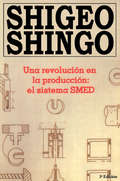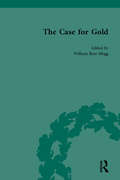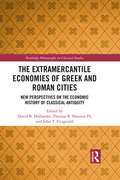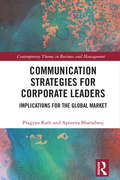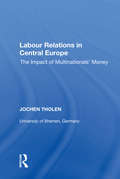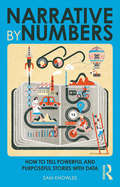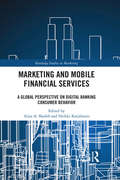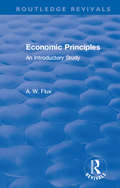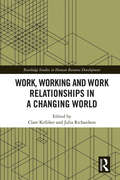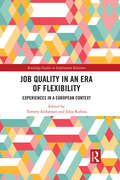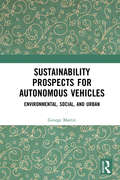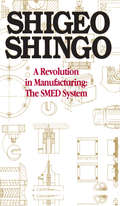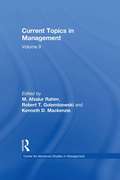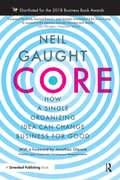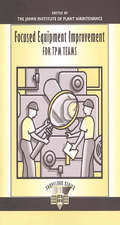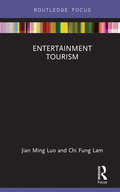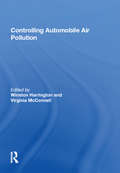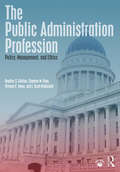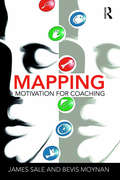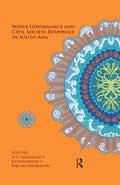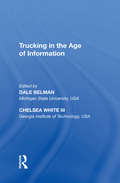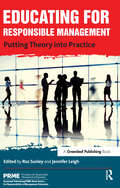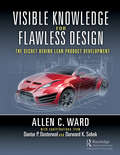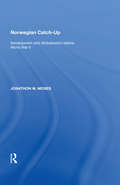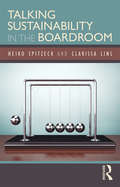- Table View
- List View
Una revolutión en la productión: el sistema SMED, 3a Edicion
by Shigeo ShingoLos Japoneses consideran a Shigeo Shingo el decano de los consultores de productividad y calidad. Ha comunicado su enfoque hacia la mejora fundamental a millaresde trabajadores, directores, y altos ejecutivos en cientos de companias tales como Toyota, Honda y Matsuchita. En eltranscurso de su carrera, el Sr. Shingo escribi ms deveinte libros los cuales revelan la profundidad de su pensamiento sobrelos principios de la ingeneria industrial; expresi?n de sudedicaci?n a la mejora de la productividad y la calidad en cadaaspecto de la fabricaci?n. El Sr. Shingo desea que entendamos porqu? fabricamos como lo hacemos -- de manera que podamos entenderc?mo debemos cambiar. Argumentando a part?r de la teorfa XY de direcci?n de McGregor, Shingo adems demanda respetogenuino para la humanidad y creatividad de los trabajadores y solicita seles de una tarea que les desaffe y utilice sus capacidades. Este libro es una lectura obligada para todo gerente ingenieroque quiera competir con ?xito en los mercados internacionales. La parte ms importante del Justo a Tiempo es el cambio rpido de todos. Muestra c?mo reducir, en forma drstica, los tiempos de cambios en un promedio de 98%!!!
The Case for Gold Vol 2
by William Rees-MoggThe role of gold in the world's exchange system has been hotly contested by leading economists. This work collects the most important arguments in favour of gold, including such works as David Ricardo's "High price of Bullion" and W. Stanley Jevons's "Money and the Mechanism of Exchange".
The Extramercantile Economies of Greek and Roman Cities: New Perspectives on the Economic History of Classical Antiquity (Routledge Monographs in Classical Studies)
by John T. Fitzgerald David B. Hollander Thomas R. BlantonRecent work on the ancient economy has tended to concentrate on market exchange, but other forces also caused goods to change hands. Such nonmarket transfers ranged from small private gifts to the wholesale confiscation of cities, lands, and their peoples. The papers presented in this volume examine aspects of this extramercantile economy, particularly benefaction and the role of associations, as well as their impact on the market economy. This volume brings together ancient historians, New Testament scholars, and classicists to assess critically the New Institutional Economics framework. Combining theoretical approaches with detailed investigations of particular regions and topics, its chapters examine Greek economic thought, the benefits of membership in private associations, and the economic role of civic euergetism from classical Athens to the municipalities of Roman Spain. The Extramercantile Economies of Greek and Roman Cities will be of use to those interested in the economic context of ancient religions, the role of associations in the economy, theoretical approaches to the study of the ancient economy, labor and politics in the ancient city, as well as how Greek philosophers, from Xenophon to Philodemus, developed ethical ideas about economic behavior.
Communication Strategies for Corporate Leaders: Implications for the Global Market (Contemporary Themes in Business and Management)
by Pragyan Rath Apoorva BharadwajCommunication is key to success in every aspect of life and ever so in a competitive business environment. This book examines managerial communication from seminal theoretical and demonstrative vantage points through interdisciplinary amalgamation of sciences and the liberal arts. It presents new paradigms of managerial communication in the form of manoeuvres that can act as game changers in tug-of-war business situations, including difficult negotiations, conflicts and interpersonal dissonance that characterise the day-to-day corporate workplace tenor. This volume: Develops persuasion strategies based on argumentation tactics derived, for example, from legal cross-examination. Introduces ‘problematisation’ and ‘deconstruction’ as effective communication tools into mainstream managerial discourse. Employs Harvard Business School cases to demonstrate problem-solving skills, which will further serve as guide to writing business reports, plans and proposals. Positions business writing methods as taxonomical tenets that can help tackle complex business scenarios. Draws business diagnostic procedures from diverse fields such as Sherlock Holmes from popular culture, and Jared M. Diamond from ecology. This book will be a significant resource for business communication practitioners, especially corporate managers and leaders, sales and marketing professionals, and policymakers. It will be of interest to teachers and students alike, in business communication, organization behaviour, human resource management and marketing communications. It will act as a useful aid for classroom efficacy for teachers and academics.
Labour Relations in Central Europe: The Impact of Multinationals' Money (Contemporary Employment Relations Ser.)
by Jochen Tholen Ludovit Czíria Eike Hemmer Wieslawa Kozek Zdenka MansfeldováSince 1990, foreign direct investment (FDI) has quickened economic modernization in Central Europe. State of the art management techniques and cutting edge technology have been introduced in many cases. Labour Relations is an essential factor in the organization of labour and production. At the start of the process industrial relations were characterized by the conditions existing under the previous planned economies or - as with "greenfield" investments - had to be entirely reconfigured. In the case of investments by West European companies, this book reveals various emerging models of industrial relations but also a clear tendency towards company centralization. For the time being the European Works Council still plays a subordinate role despite its potential fundamental role as mediator between East and West. Empirically nine corporations from the metal/automotive industry, the chemical, energy and food processing industries (with their subsidiaries in Poland, Czech Republic and Slovakia) are considered.
Narrative by Numbers: How to Tell Powerful and Purposeful Stories with Data (Using Data Better)
by Sam KnowlesShortlisted for the Business Book of the Year Awards in the Sales and Marketing category. As jobs become increasingly similar, there are two skills that everyone needs if they’re going to thrive. These are the ability to interrogate and make sense of data, and the ability to use insights extracted from data to persuade others to act. Analytics + storytelling = influence. Humans are hardwired to respond to stories and story structure. Stories are how we make sense of and navigate the world. We respond best to stories that are based on evidence. But storytellers need to use data as the foundation of stories, not as the actual stories themselves. To be truly impactful, rational facts need to be presented with a veneer of emotion. The Big Data revolution means more data is available than ever. The trouble is, most people aren’t very numerate or good at statistics. Many find it hard to look at data and extract insights. Meanwhile, those for whom numbers hold no fear don’t always make the best storytellers. They mistakenly believe they need to prove their point by showing their workings. There are some simple and effective rules of data-driven storytelling that help everyone tell more compelling, evidence-based stories, whoever they need to convince. Narrative by Numbers shows you how.
Marketing and Mobile Financial Services: A Global Perspective on Digital Banking Consumer Behaviour (Routledge Studies in Marketing)
by Aijaz A. Shaikh Heikki KarjaluotoMobile financial services (MFS) are of major interest and importance to both researchers and practitioners. The role played by nonbanking actors including telecoms and FinTech firms as well as other participants, such as PayPal and Amazon, in developing and deploying innovative financial and payment services is undeniable. Peer2peer (P2P) payments from nonbank services are becoming increasingly commonplace and will shortly be codified by EC (EU?) regulations requiring banks to provide access to consumer data for third-party app developers and service providers. Three major mobile financial systems—mobile banking, mobile payments, and branchless banking—currently dominate the electronic retail banking sector. Although interconnected and interrelated, their business models, regulatory frameworks, and target markets are distinct. This book provides a unified perspective on MFS and discusses its evolution, growth, and future, as well as identifying the frameworks, stakeholders, and technologies used in financial information systems in general and MFS in particular. Academics and researchers in digital and financial marketing will find this book an invaluable resource, as will bank executives, regulators, policy makers, FinTech professionals, and anyone interested in how mobile technology, social media and financial services will increasingly intersect.
Revival: An Introductory Study (Routledge Revivals)
by A.W. FluxThe text contains no explicit reference to mathematical apparatus which has rendered eminient service in economics, especially in recent years. Some of the simpler applications of algebraic symbols and geometrical diagrams to econcomic problems are presented in an appendix. Those to whom these forms of expression tend rather to confuse than to clarify the reasoning which they embody, may thus readily spare themselves this confusion; while those to whom symbols are familiar and helpful will not be deprived of the aid to precision of conception and of argument which can hardly be afforded in equal degree by any other means.
Work, Working and Work Relationships in a Changing World (Routledge Studies in Human Resource Development)
by Clare Kelliher Julia RichardsonThis book is concerned with the rapid and varied changes in the nature of work and work relationships which have taken place in recent years. While technological innovation has been a key contributor to the nature and pace of change, other social and market trends have also played a part such as increasing workforce diversity, enhanced competition and greater global integration. Responding to these trends alongside cost pressures and the need for continued responsiveness to the environment, organizations have changed the way in which work is organized. There have also been shifts in product markets with growing demand for authenticity and refinement of the customer experience which has further implications for how work is organized and enacted. At the same time, employees have sought changes in their work arrangements in order to help them achieve a more satisfactory relationship between their work and non-work lives. Many have also taken increased responsibility for managing their own work opportunities, moving away from dependency on a single employer. The implications of these significant and widespread changes are the central focus of this book and in particular the implications for workers, managers, and organizations. It brings together contributions from an international team of renowned management scholars who explore the opportunities and challenges presented by technological and digital innovation, consumer, social and organizational change. Drawing on empirical evidence from Europe, North America and Australia, Work, Working and Work Relationships in a Changing World considers new forms of service work, technologically enabled work and independent professionals to provide in-depth insight into work experiences in the 21st Century.
Job Quality in an Era of Flexibility: Experiences in a European Context (Routledge Studies in Employment Relations)
by Tommy Isidorsson Julia KubisaThis is the era of flexibility. Under constant pressure to be adaptable, organizations increasingly adopt employment practices such as zero-hours contracts, the casualization of the workforce and the use of temporary and agency labour. These flexible practices are central to debates about the changing nature of job quality and its causes, trends and consequences. Arguing that job quality is central to understanding contemporary work, this book explores the internal and external pressures for flexibility in workplaces, professions and sectors and how this pressure shapes workers’ experiences of job quality. By studying job quality dynamics via case studies from organizations and occupations in the UK, Poland, Belgium and Sweden, the volumes illustrates the diversity of practices and experiences, as well as market pressures and institutional arrangements which effect working lives. Finally, the editors propose a policy debate on the new concept "flexiquality" - a combination of flexibility and job quality that can be beneficial for both management and workers.
Sustainability Prospects for Autonomous Vehicles: Environmental, Social, and Urban
by George T. MartinThe Autonomous Vehicle (AV) has been strongly heralded as the most exciting innovation in automobility for decades. Autonomous Vehicles are no longer an innovation of the future (seen only in science fiction) but are now being road-tested for use. And yet while the technical and economic success and possibilities of the AV have been widely debated, there has been a notable lack of discussion around the social, behavioural, and environmental implications. This book is the first to address these issues and to deeply consider the environmental and social sustainability outlook for the AV and how it will impact on communities. Environmental and social sustainability are goals unlike those of technical development (a new tool) and economic development (a new investment). The goal of sustainability is development of societies that live well and equitably within their ecological limits. Is it reasonable and desirable that only technical and economic success comprise the swelling AV parade, or should we be looking at the wider impacts on personal well-being, wider society, and the environment? The uptake for AVs looks to be lengthy, disjointed, and episodic, in large measure because it faces a range of known unknown risks. This book assesses the environmental and social sustainability potential for AVs based on their prospective energy use and their impacts on climate change, urban landscapes, public health, mobility inequalities, and individual and social well-being. It examines public attitudes about AV use and its risk of fostering a rebound effect that compromises potential sustainability gains. The book concludes with a discussion of critical issues involved in sustainable AV diffusion.
A Revolution in Manufacturing: The SMED System
by Shigeo ShingoWritten by the industrial engineer who developed SMED (single-minute exchange of die) for Toyota, A Revolution in Manufacturing provides a full overview of this powerful just in time production tool. It offers the most complete and detailed instructions available anywhere for transforming a manufacturing environment in ways that will speed up produ
Current Topics in Management: Volume 9 (Center for Advanced Studies in Management)
by M. Afzalur Rahim, Robert T. Golembiewski and Kenneth D. MackenzieThis annual series presents research on the theory and practice of management. Volume 9 includes papers presented at the 2003 joint conference of the International Conference on Advances in Management (ICAM) and Korean Association of Public Administration. This volume exemplifies ICAM's comparative orientiation in its broad scope of management perspectives, in its diverse locations of its research as well as its application, and in its comparisons of findings, methodologies, and operational definitions. Part 1, "Organization Theory, Change, and Effectiveness," discusses the relationship between ethical orientation and crisis management, before and after the World Trade Center attacks, and high success rates of organizational development and modern Hindu work ethics. Part 2, "Behavior and Attitudes in Organizations," offers a nuanced perspective on organization's behavior, academic wisdom versus practical realities in organization, and regulatory focus as a determinant of occupational status. Part 3, "Business and Society, Ethics and Values," looks at crises in corporations and government due to corruption and unethical behavior. Part 4, "International and Cross-Cultural Management," looks at studies on leader power and how it is associated with subordinates' conflict-management strategies and propensity to leave a job in four countries, the role of commitment to change as it is associated with reaction to organizational change in India, and effective management of interdepartmental conflict in Greece. Part 5 looks at the number of levels in multi-level organizational research. This volume will be of particular interest to corporate executives, economists, and labor studies specialists.
CORE: How a Single Organizing Idea can Change Business for Good
by Neil GaughtCORE is shortlisted for the Best Business Book Awards in the Engaging Change category. At the core of the world's most admired businesses lies a powerful Single Organizing Idea. These organizations deliver sustainable economic and social benefit; they unite people, attract investment, inspire innovation, pioneer new efficiencies, and enjoy positive reputation. Such businesses are admired but they remain a rare breed. Though the tides of change are engaging the minds of business leaders, most are still trapped behind their brands and an approach to corporate social responsibility that is out of step with a connected society that increasingly questions 'who' these businesses really are and what drives their purpose. This book is about how businesses can adopt a Single Organizing Idea and, more importantly, why they have to. Drawing on stories and case studies, and with reference to the UN's Sustainable Development Goals, its no-nonsense approach sets aside the ideals to confront the realities of business reform. It demonstrates the power and potential that a Single Organizing Idea can bring to any business prepared to take its head out of the sand and proactively respond to today's challenges.
Focused Equipment Improvement for TPM Teams (The\shopfloor Ser.)
by Japan Institute of Plant MaintenanceAs distinguished from autonomous maintenance, where the main goal is to restore basic conditions of cleanliness, lubrication, and proper fastening to prevent accelerated deterioration, FEI looks at specific losses or design weaknesses that everyone previously thought they just had to live with. Once your TPM operator teams are progressing with their daily autonomous maintenance activities, you will want to take the next advanced step in TPM training with this book. Key Features: a simple and powerful introduction to P-M Analysis hints for unraveling breakdown analysis numerous ideas for simplifying and shortening setups ideas for eliminating minor stoppages and speed losses basic concepts of building quality into processing real-life examples from a leading Japanese tool company
Entertainment Tourism (Routledge Focus in Tourism #1)
by Jian Ming Luo Chi Fung LamEntertainment tourism has recently become more popular. Entertainment attractions encourage tourists to travel around the world to have fun and are an important part of many gaming destinations. This book explores the tourist experience in entertainment destinations. It introduces and outlines the concept of entertainment and tourism in the global environment, focusing on entertainment tourism development in Las Vegas, USA and Macau, China. Macau has become one of the most famous gaming destinations in the world, now surpassing Las Vegas in terms of gaming revenue. This book explores the market for entertainment tourism market and major trends, such as Virtual Reality, as well as the experience of tourists using entertainment products. This book is a valuable resource not only for social science researchers, but also for those in related fields, such as entertainment service providers and tourism officers, among many others.
Controlling Automobile Air Pollution (The\international Library Of Environmental Economics And Policy Ser.)
by Virginia McConnellThis volume includes many of the most influential and interesting academic articles related to the economics of mobile source pollution control. The papers included explore why vehicles and vehicle markets are unique, provide estimates of the type and magnitude of the social costs of driving and examine estimation methods and estimates of the various elasticities of vehicle demand. Analysis of the social costs and policies to reduce both traditional air pollutants and greenhouse gas emissions are included. Selected articles review the range of evaluation of both regulatory and market-based approaches to controlling emissions. The complexity of the effects of different policies are emphasized and the unintended consequences of regulation are explored in the context of vehicle emissions reduction policies.
The Public Administration Profession: Policy, Management, and Ethics
by Bradley S. Chilton Stephen M. King Viviane E. Foyou J. Scott McDonaldWhile many introductory public administration textbooks contain a dedicated chapter on ethics, The Public Administration Profession is the first to utilize ethics as a lens for understanding the discipline. Analyses of the ASPA Code of Ethics are deftly woven into each chapter alongside complete coverage of the institutions, processes, concepts, persons, history, and typologies a student needs to gain a thorough grasp of public service as a field of study and practice. Features include: A significant focus on "public interests," nonprofit management, hybrid-private organizations, contracting out and collaborations, and public service at state and local levels. A careful examination of the role that religion may play in public servants’ decision making, as well as the unignorable and growing role that faith-based organizations play in public administration and nonprofit management at large. End-of-chapter ethics case studies, key concepts and persons, and dedicated "local community action steps" in each chapter. Appendices dedicated to future public administration and nonprofit career management, writing successful papers throughout a student’s career, and professional codes of ethics. A comprehensive suite of online supplements, including: lecture slides; quizzes and sample examinations for undergraduate and graduate courses containing multiple choice, true-false, identifications, and essay questions; chapter outlines with suggestions for classroom discussion; and suggestions for use of appendices, e.g., how to successfully write a short term paper, a brief policy memo, resume, or a book review. Providing students with a comprehensive introduction to the subject while offering instructors an elegant new way to bring ethics prominently into the curriculum, The Public Administration Profession is an ideal introductory text for public administration and public affairs courses at the undergraduate or graduate level.
Mapping Motivation for Coaching (The Complete Guide to Mapping Motivation)
by James Sale Bevis MoynanMapping Motivation for Coaching, co-written with Bevis Moynan, is the first of a series of six books that are all linked to the author's Motivational Map toolkit. Each book builds on a different aspect of personal, team, and organisational development. This book is a practical guide to understanding how personal and career development is underpinned by motivation, and how coaching and mapping are perfectly complementary activities. More specifically, it shows how using Motivational Maps within an accepted coaching framework can not only accelerate the process in order to achieve results for the client more quickly, but also go deeper, both in mutual understanding and also the possibility of facilitating a successful outcome; for the client not only needs to understand their issue more effectively through the coaching process, but also needs to be motivated to want to take significant action to deal with it. Understanding, then, is one thing, but having the energy for follow-through is another, and it is precisely in this area that combining Maps with coaching techniques is so powerful. This highly original approach will enable all coaches everywhere in the world to get into the heart of their clients’ issues faster, better, and be able to help them solve these issues more easily.
Water Governance and Civil Society Responses in South Asia
by S. Parasuraman N. C. Narayanan Rajindra AriyabanduThis book addresses paradigm shifts in water policy and governance, and examines the role of civil society organizations in influencing public policy, while focusing on social equity and democratic participation. It illustrates a range of interesting developments in policy formulation, donor–state nexus, and interventions by civil society and voluntary organizations. The collection of articles provides a comprehensive and current narrative of the state–society relations in South Asia under neoliberal governance reforms, their implications and key responses with regard to water policies. Using case studies, it closely investigates the impact, effectiveness, drawbacks and challenges faced by voluntary organizations and social movements working at various levels in the water sector. The work will interest researchers and students of development studies, environmental studies, natural resource management, water governance, and public administration, as also water sector professionals, policymakers, civil society activists and governmental and non-governmental organizations.
Trucking in the Age of Information
by Dale Belman Chelsea White IIITrucking in the Age of Information provides a comprehensive overview of the contemporary trucking industry. Prior research on trucking has focused on the effects of deregulation on the industry, but the industry's current transformation is driven by information technology, emerging business strategies, globalization of commodity production and the rise of package express and logistics. The volume brings together acknowledged and emerging scholars of the industry including Thomas Corsi (University of Maryland), Chelsea White III (Georgia Tech), Starr McMullen (Oregon State University), Will Mitchell (Duke University), Jeff Liker (University of Michigan), Francine LaFontaine (University of Michigan), Kristen Monaco (California State University at Long Beach) and Michael Conyngham (International Brotherhood of Teamsters) to address issues including technological change, third party logistics, lean trucking, driver safety and health, homeland security and the consolidation of trucking services. Each chapter provides an overview of industry issues and a discussion of current research.
Educating for Responsible Management: Putting Theory into Practice (The Principles for Responsible Management Education Series)
by Roz Sunley Jennifer LeighIt is well known the global community is looking towards business to play its role in creating a just and fair economy. This increases the urgency and relevance of new approaches to management education that can engage and foster socially responsible leaders who are resilient, creative and innovative thinkers. Educating for Responsible Management profiles cutting-edge approaches to pedagogy for the Principles for Responsible Management Education (PRME) that go beyond current discussions of sustainability and corporate social responsibility content, to include a wider lens that highlights the processes of educating the next generation of responsible managers. The book draws together leading thinkers, practitioners and management education to share their practice and research on how management educators can prepare themselves, their students, the learning environment, and their teaching resources to meet these challenges. These conversations across practice lines highlight a range of innovative pedagogical approaches and methods used by responsible management educators around the world to provide effective learning experiences.
Visible Knowledge for Flawless Design: The Secret Behind Lean Product Development
by Dantar P. Oosterwal Allen C. Ward Durward K. Sobek IIVisible knowledge is a tool nearly lost in the West, but it has been used to great effect by Toyota in its 50-year march from noncompetitiveness to its current status as the second largest automobile company in the world. It is key for the 50% growth in market share Toyota plans for this decade despite worldwide overcapacity in the auto business. This book presents the reader with a systematic approach to create, capture, and display knowledge in a way that allows development teams to optimize the design of their products and production processes. Visible knowledge not only applies to knowledge management, but provides a means of collaboration to facilitate better decision-making in the development process. This book has evolved out of a manuscript that Allen Ward, the foremost U.S. expert on lean product development, was writing at the time of his untimely death. It is not intended to be a treatise of Lean product development methods. Quite the opposite—it is focused on one small piece, "visible knowledge." It is, however, one technique that Dantar Oosterwal and Durward Sobek have found to be very effective at Harley-Davidson and other places, and a tool that can make a difference whether used by itself or as a starting point for a larger journey into Lean product development. In completing this work, Oosterwal and Sobek kept the aim true to Allen’s original intent. The preface and first three chapters are essentially Allen’s original intellectual contribution. They have made editorial changes to improve readability and clarity of explanation. Throughout, they have attempted to preserve Allen’s voice in the writing, even keeping the narrative in first person as it was originally written. They have also added a fourth chapter that highlights some practical ways to apply the ideas presented in earlier chapters, illustrated with case examples from their experience.
Norwegian Catch-Up: Development and Globalization before World War II (Routledge Revivals Ser.)
by Jonathon W. Moses'Norwegian Catch-Up' looks at the early Norwegian economic trajectory in the light of its external commitments and opportunities. Detailing Norway's economic performance relative to other countries at a time characterized by globalization, it has a particular focus on the role of international trade, investment and migration. The book examines how a small open state adapted successfully to the demands of (and opportunities provided by) a global market place. Not only did Norway manage an impressive economic record, but it developed concomitantly a strong and articulate labor movement and resilient democratic institutions. In short, the Norwegian example provides hope for development in a context of globalization. This text provides the student with a pioneering new vantage point for understanding the nature and scope of today's globalization and its effect on economic (and political) development. It also provides a historical reflection on the liberal antecedent of modern social democracy.
Talking Sustainability in the Boardroom
by Heiko Spitzeck Clarissa LinsA Global CEO study by Accenture and the UN Global Compact has shown that 94% of CEOs think that their board should discuss sustainability. And yet there is a real danger that boards are not living up to expectations on sustainability, paying lip-service to the concept rather than fully embedding social and environmental issues into their strategies and operations. Talking Sustainability in the Boardroom sets out why this is the case, identifies the obstacles, and then explains the opportunities for the long-term performance of the organisation that can arise through focusing on social and environmental issues. Written by two leading specialists in sustainability who have significant experience of working directly with boards, this book presents a very practical framework for embedding sustainability into board conversations and strategies. Steps include identifying and prioritising the social and environmental issues that are most pertinent to the organisation and will have the biggest impact on business, presenting the competences and skills to enable this, guidance on how to structure board meetings to ensure that these conversations truly take place, and the development of action plans and tools for measurement.
